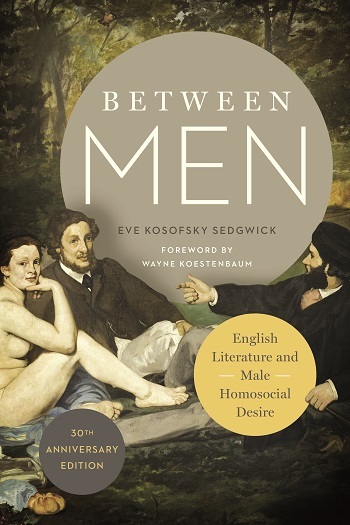The Legacy of Eve Sedgwick
On the heels of the recent publication of the Thirtieth Anniversary edition of Between Men: English Literature and Male Homosocial Desire, The New Yorker‘s blog, The Page Turner, posted a piece on the book and Eve Sedgwick’s legacy.
The article by Jane Hu, “Between Us: A Queer Theorist’s Devoted Husband and Enduring Legacy,” begins by describing how her husband, Hal, is preserving Sedgwick’s archive to insure that her work endures. As the piece points out, at least in the immediate future there is little danger that Sedgwick’s ideas and influence fading away. Scholarly journals continue to devote issues to her and there are or have been multiple conferences dedicated to her book, including a recent one at the CUNY Grad Center on Between Men.
In addition to citing Sedgwick’s scholarly impact, Hu also describes Sedgwick’s intellectual and personal bravery. Critics from all directions — feminists, gay men, etc. — asked her to account for herself. Her writing, unlike much academic work, would often be very personal and even confessional, and has served as an inspiration to other scholars and critics.
In describing the influence of Between Men and the recent conference on Between Men, Jane Hu writes:
Hal [Eve Sedgwick’s husband] showed me around Eve’s archives the day after the most recent of these conferences, celebrating the thirtieth anniversary of “Between Men,” a groundbreaking book that popularized the term “homosocial.” At the conference, Jennifer Crewe, the president of Columbia University Press, recalled how typists working on it constantly rendered the word as “homosexual” because of just how unusual the term was in 1985.
“Between Men” not only put Sedgwick on the map as a queer theorist, it helped to establish the field of queer literary analysis. Sedgwick became, as Rolling Stone once put it, “the soft-spoken queen of the constructionists.” (A speaker at the conference noted the shocking disjunction between Sedgwick’s quiet speaking voice and the bold statements she made in print.) The book was published during a heated period of the gay liberation movement; as Wayne Koestenbaum notes in his forward to a new edition, the H.I.V. retrovirus had been isolated a year before, and ACT UP was formed just two years afterward.




